目录
题目九:OOP CString字符串拼接(深拷贝与运算符重载)
题目一:分数的加减乘除(运算符重载)
题目描述:
Fraction类的基本形式如下:

要求如下:
1.实现Fraction类;common_divisor()和contracted()函数体可为空,不实现具体功能。
2.编写main函数,初始化两个Fraction对象的,计算它们之间的加减乘除。
输入要求:
第1行:依次输入第1个和第2个Fraction对象的分子和分母值。
输出要求:
每行依次分别输出加减乘除计算后的Fraction对象(直接输出分数值,不需要约简)。
输入样例:
1 3 2 5输出样例:
fraction=11/15
fraction=-1/15
fraction=2/15
fraction=5/6代码示例:
#include<iostream>
#include<iomanip>
#include<cstring>
#include<string>
#include<cmath>
#include<algorithm>
using namespace std;
class Fraction {
private:
int numerator, denominator;
int common_divisor() {};
int contracted() {};
public:
Fraction(int x = 0, int y = 1) :numerator(x), denominator(y) {}
Fraction(Fraction& fra)//拷贝构造函数
{
numerator = fra.numerator;
denominator = fra.denominator;
}
Fraction operator + (Fraction& fra)//类内运算符重载:类名 + operator + 需要重载的运算符(类引用)
{
Fraction f;
f.numerator = numerator * fra.denominator + fra.numerator * denominator;
f.denominator = denominator * fra.denominator;
return f;
}
Fraction operator - (Fraction& fra)
{
Fraction f;
f.numerator = numerator * fra.denominator - fra.numerator * denominator;
f.denominator = denominator * fra.denominator;
return f;
}
Fraction operator * (Fraction& fra) {
Fraction f;
f.numerator = numerator * fra.numerator;
f.denominator = denominator * fra.denominator;
return f;
}
Fraction operator / (Fraction& fra)
{
Fraction f;
f.numerator = numerator * fra.denominator;
f.denominator = denominator * fra.numerator;
return f;
}
void Set(int x, int y)
{
numerator = x;
denominator = y;
}
void disp() {
cout << "fraction=" << numerator << "/" << denominator << endl;
}
};
int main()
{
int a, b;
cin >> a >> b;
Fraction f1(a, b);
cin >> a >> b;
Fraction f2(a, b);
Fraction f3;
f3 = f1 + f2;
f3.disp();
f3 = f1 - f2;
f3.disp();
f3 = f1 * f2;
f3.disp();
f3 = f1 / f2;
f3.disp();
return 0;
}题目二:四进制加法(运算符重载)
题目描述:
定义一个四进制的类,重定义“+”号实现四进制数的累加。
输入要求:
第一行输入所需要的四进制数的个数
第二行开始,依次输入四进制数
输出要求:
所有输入四进制数累加的和
输入样例:
3
13
2
21输出样例:
102代码示例:
#include<iostream>
#include<iomanip>
#include<cstring>
#include<string>
#include<cmath>
#include<algorithm>
using namespace std;
class Quaternary
{
private:
int num;
public:
Quaternary(int nn = 0) :num(nn) {}
void Set(int nn)
{
num = nn;
}
Quaternary operator+(Quaternary& rhs)
{
int sum, a;
int n = 0;
int total = 0;
sum = num + rhs.num;
a = sum;
while (a)//十进制转化成四进制的方法
{
a /= 10;
n++;
}
for (int i = 0; i < n + 1; i++)
{
if (sum % 10 >= 4)
{
sum = (sum / 10 + 1) * 10 + sum % 10 - 4;
}
total += sum % 10 * pow(10, i);
sum /= 10;
}
Quaternary qu(total);
return qu;
}
void print() {
cout << num << endl;
}
};
int main() {
int n, x;
cin >> n;
Quaternary* q;
Quaternary qua;
q = new Quaternary[n];
for (int i = 0; i < n; i++)
{
cin >> x;
q[i].Set(x);//动态内存分配的初始化
}
for (int i = 0; i < n; i++)
{
qua = qua + q[i];
}
qua.print();
}注意四进制转化成十进制再转化为四进制的算法;
题目三:人民币输出(输入输出运算符重载)
题目描述:
定义一个人民币类,包括元、角、分三个非负整数属性,操作包括输入和输出
输入通过重载运算符>>实现,接收一个浮点数参数(精度为小数点后两位),并转化为元、角、分,例如输入1.23元,转为1元、2角、3分
输出通过重载运算符<<实现,对元角分进行输出,具体格式看示例
由于OJ编译器对double强制类型转换成int的处理精度有偏差,建议加0.005处理(例如数据1.38,由于误差,在内存中的存储值为1.379999)
输入要求:
第一行输入t表示有t个实例
第二行起,输入t个正浮点数,带两位小数,每个数值表示以元为单位的人民币金额
输出要求:
每行输出把浮点数的人民币金额,转化为元角分的整数格式,具体看输出
输入样例:
2
2.45
1.38
输出样例:
yuan=2 jiao=4 fen=5
yuan=1 jiao=3 fen=8代码示例:
#include<iostream>
#include<iomanip>
#include<cstring>
#include<string>
#include<cmath>
#include<algorithm>
using namespace std;
class RMB
{
private:
float money;
int yuan;
int jiao;
int fen;
public:
RMB() {}
friend istream& operator>>(istream& in, RMB& rhs);//输入输出流的运算符重载,记住格式
friend ostream& operator<<(ostream& out, RMB& rhs);//friend ostream/istream & operator <</>> (ostream/istream & ,类引用)
};
istream& operator>>(istream& in, RMB& rhs)
{
in >> rhs.money;//直接输入数据至类内
rhs.yuan = (int)rhs.money;
rhs.jiao = ((int)(rhs.money * 10)) % 10;
rhs.fen = ((int)(rhs.money * 100)) % 10;
return in;
}
ostream& operator<<(ostream& out, RMB& rhs)
{
out << "yuan=" << rhs.yuan << " " << "jiao=" << rhs.jiao << " " << "fen=" << rhs.fen << endl;
return out;
}
int main()
{
int t;
cin >> t;
while (t--)
{
RMB rmb;
cin >> rmb;
cout << rmb;
}
return 0;
}注意输入输出运算符重载的格式,记住就行了!
题目四:字符串比较(运算符重载)
题目描述:
定义一个字符串类str,用来存放不定长的字符串,重载运算符"= ="、"<"、">",用于两个字符窜的等于、小于和大于的比较运算。
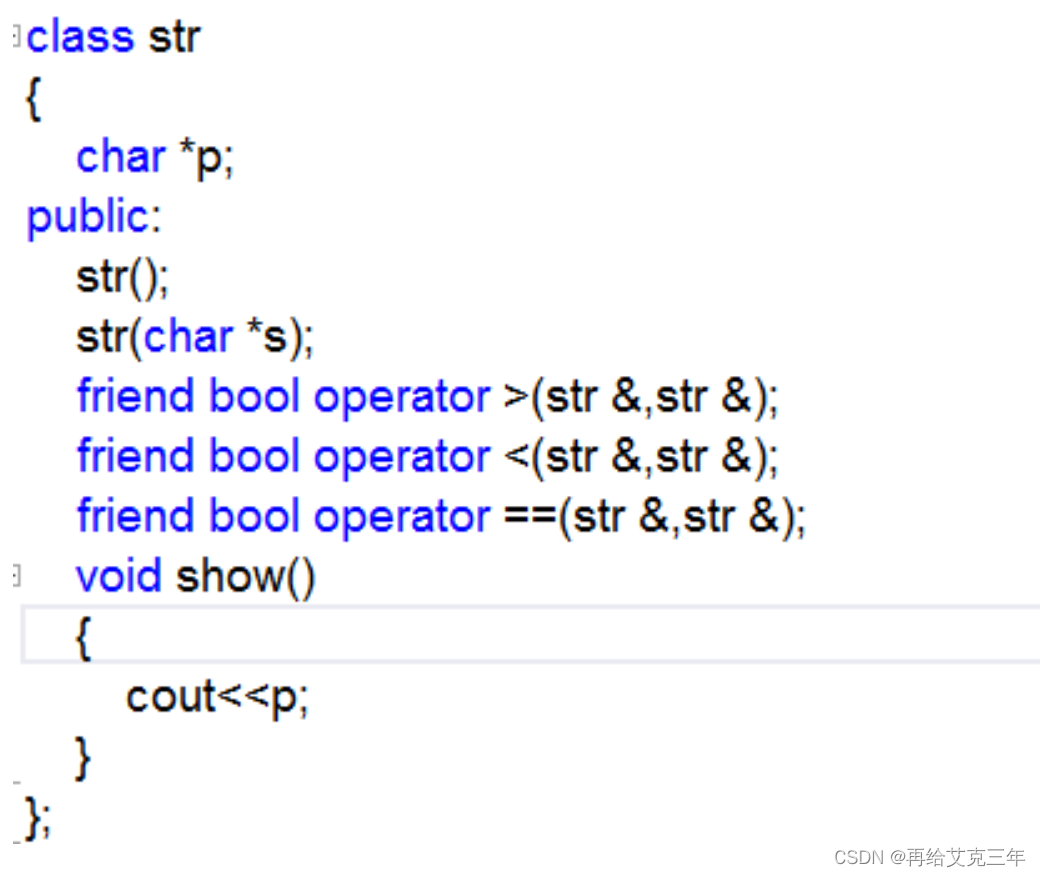
要求如下:
1.实现str类;
2.编写main函数,初始化三个str对象A、B、C,然后用这三个对象去测试重载的运算符。如果A>B,则输出A的字符串;否则输出B的字符串。如果A<C,则输出A的字符串;否则输出C的字符串。如果B==C,则输出B的字符串;否则输出C的字符串。
输入要求:
输入3行,每行为一个字符串,初始化三个str对象。
输出要求:
输出比较之后的结果字符串,每个比较的结果一行。
输入样例:
i am a student
i love China
i love China输出样例:
i love China
i am a student
i love China代码示例:
#include<iostream>
#include<iomanip>
#include<cstring>
#include<string>
#include<cmath>
#include<algorithm>
using namespace std;
class str
{
char* p;
public:
str() = default;//初始化构造
str(const char* s)
{
p = new char[strlen(s) + 1];
strcpy(p, s);//s串赋给p指针
}
friend bool operator > (str& lhs, str& rhs)//友元类型的运算符重载
{
return strcmp(lhs.p, rhs.p) > 0;
}
friend bool operator < (str& lhs, str&rhs)
{
return strcmp(lhs.p, rhs.p) < 0;
}
friend bool operator == (str& lhs, str& rhs)
{
return strcmp(lhs.p, rhs.p) == 0;
}
void show()
{
cout << p << endl;
}
};
int main()
{
string s1, s2, s3;
getline(cin, s1);//输入带空格的字符串
getline(cin, s2);
getline(cin, s3);
str A(s1.c_str()), B(s2.c_str()), C(s3.c_str());//c_str() 函数可以将 const string* 类型 转化为 const char* 类型
if (A > B)
A.show();
else
B.show();
if (A < C)
A.show();
else
C.show();
if (B == C)
B.show();
else
C.show();
return 0;
}注意友元函数运算符重载与类内运算符重载的区别,前者是(两个引用),后者是(一个引用);以及c_str()函数的用法,注意加string头文件!!
题目五:矩形关系(运算符重载)
题目描述:
假设坐标采用二维平面坐标。
定义点类CPoint,包含属性x,y(整型)。方法有:带参构造函数,getX,getY分别返回点的x坐标,y坐标。
定义矩形类CRectangle,包含属性:矩形的左上角坐标leftPoint,右下角坐标rightPoint。类中方法有:
1)带参构造函数,初始化矩形的左上角、右下角
2)重载>运算符,参数为CPoint点对象,假设为p,若p在矩形内,返回true,否则返回false。
3)重载>运算符,第一个矩形若包含第二个矩形(部分边界可以相等),返回true,否则返回false。(要求该函数调用2)实现)
4)重载==运算符,判断两个矩形是否一致,返回true或false。
5)重载*运算符,判断两个矩形是否有重叠部分,返回true或false。
6)重载类型转换运算符,计算矩形的面积并返回,面积是整型。
7)重载<<运算符,输出矩形的两个角坐标和面积,具体格式见样例。
输入2个矩形,计算面积,判断矩形的关系。主函数如下,不可修改。
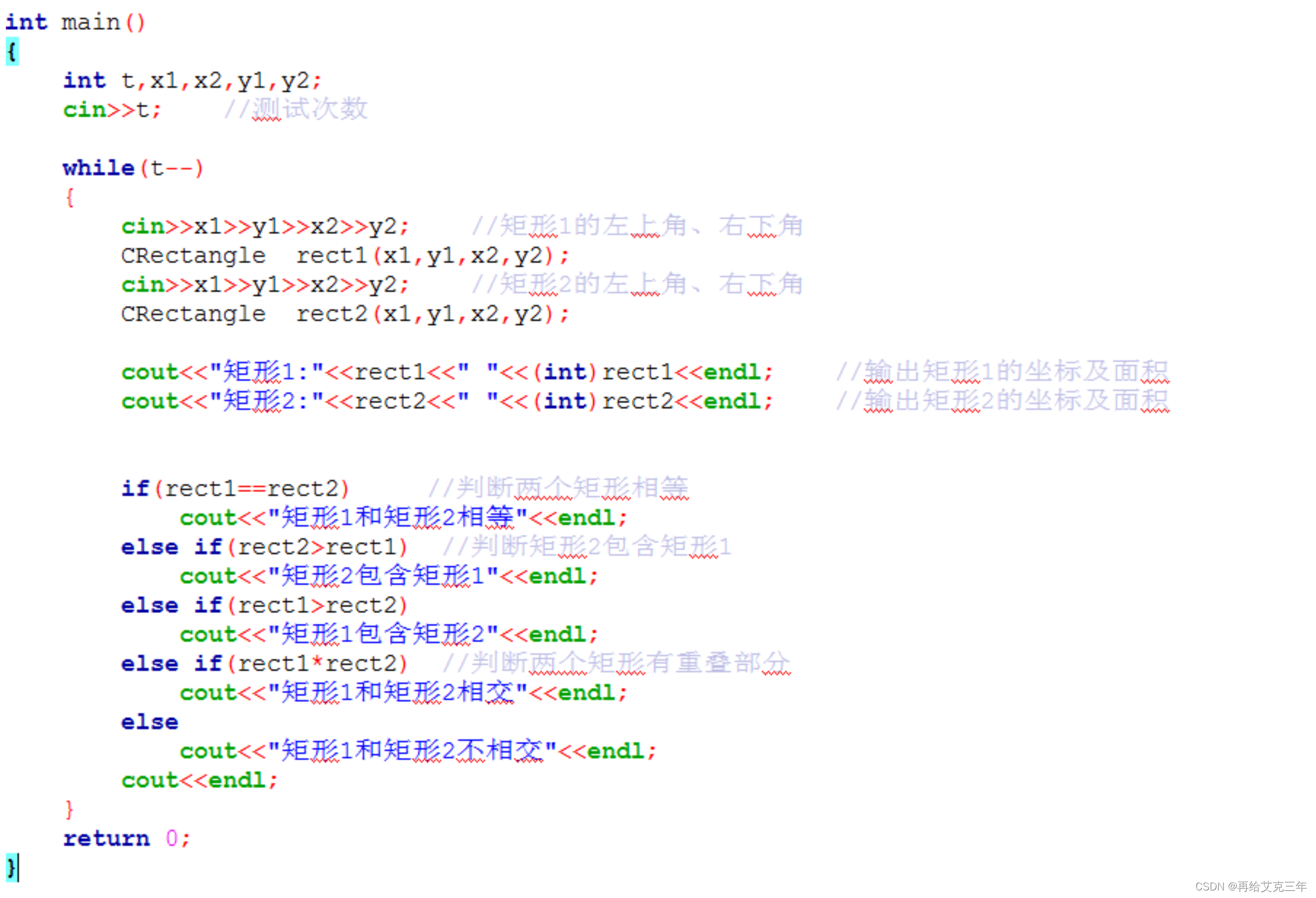
可根据需要,添加构造函数和析构函数。
输入要求:
测试次数
每组测试数据如下:
矩形1的左上角、右下角坐标
矩形2的左上角、右下角坐标
输出要求:
每组测试数据输出如下,中间以空行分隔:
矩形1的坐标和面积(具体格式见样例)
矩形2的坐标和面积(具体格式见样例)
矩形1和矩形2的关系(矩形1包含矩形2、矩形2包含矩形1、矩形2和矩形1相等、矩形1和矩形2相交、矩形1和矩形2不相交)
输入样例:
2
1 4 4 1
2 3 3 2
1 4 4 1
0 3 5 2
输出样例:
矩形1:1 4 4 1 9
矩形2:2 3 3 2 1
矩形1包含矩形2
矩形1:1 4 4 1 9
矩形2:0 3 5 2 5
矩形1和矩形2相交代码示例:
#include<iostream>
#include<iomanip>
#include<cstring>
#include<string>
#include<cmath>
#include<algorithm>
using namespace std;
class Point
{
int x, y;
public:
Point(int xx, int yy) :x(xx), y(yy) {}
int getX() { return x; }
int getY() { return y; }
};
class Rectangle
{
private:
Point leftPoint, rightPoint;
public:
Rectangle(int xv1, int yv1, int xv2, int yv2) :leftPoint(xv1, yv1), rightPoint(xv2, yv2) {}
bool operator > (Point& p)
{
if (p.getX() >= leftPoint.getX() && p.getX() <= rightPoint.getX() && p.getY() <= leftPoint.getY() && p.getY() >= rightPoint.getY())
{
return true;
}
else
{
return false;
}
}
bool operator > (Rectangle& rhs)
{
if (*this > rhs.leftPoint && *this > rhs.rightPoint)//此处调用上一个运算符重载
{
return true;
}
else
{
return false;
}
}
bool operator == (Rectangle& rhs)
{
if (this->rightPoint.getX() == rhs.rightPoint.getX() && this->leftPoint.getY() == rhs.leftPoint.getY() && this->rightPoint.getX() == rhs.rightPoint.getX() && this->rightPoint.getY() == rhs.rightPoint.getY())
{
return true;
}
else
{
return false;
}
}
bool operator * (Rectangle& rhs)
{
if (rhs.leftPoint.getX() > rightPoint.getX() || rhs.leftPoint.getY() < rightPoint.getY() || rhs.rightPoint.getX() < leftPoint.getX() || rhs.rightPoint.getY() > leftPoint.getY())
{
return false;
}
else
{
return true;
}
}
operator int()//int类型的运算符重载
{
int area = (rightPoint.getX() - leftPoint.getX()) * (leftPoint.getY() - rightPoint.getY());
return area;
}
friend ostream& operator<<(ostream& out, Rectangle& rhs);
};
ostream& operator<<(ostream& out, Rectangle& rhs)
{
out << rhs.leftPoint.getX() << " " << rhs.leftPoint.getY() << " " << rhs.rightPoint.getX() << " " << rhs.rightPoint.getY();
return out;
}
int main()
{
int t, x1, x2, y1, y2;
cin >> t;
while (t--)
{
cin >> x1 >> y1 >> x2 >> y2;
Rectangle rect1(x1, y1, x2, y2);
cin >> x1 >> y1 >> x2 >> y2;
Rectangle rect2(x1, y1, x2, y2);
cout << "矩形1:" << rect1 << " " << (int)rect1 << endl;
cout << "矩形2:" << rect2 << " " << (int)rect2 << endl;
if (rect1 == rect2)
{
cout << "矩形1和矩形2相等" << endl;
}
else if (rect2 > rect1)
{
cout << "矩形2包含矩形1" << endl;
}
else if (rect1 > rect2)
{
cout << "矩形1包含矩形2" << endl;
}
else if (rect1 * rect2)
{
cout << "矩形1和矩形2相交" << endl;
}
else
{
cout << "矩形1和矩形2不相交" << endl;
}
cout << endl;
}
return 0;
}运算符重载一定要有返回值!!
题目六:矩阵(运算符重载)
题目描述:
下面主函数和Array类完成矩阵的输入、输出。请补齐Array类中需要的成员函数。
注意:主函数和CArray类已给代码不可修改,只可在CArray类中添加新的成员函数。修改已改代码不计分。
提示:根据已给代码分析CArray需要重载哪些运算符?
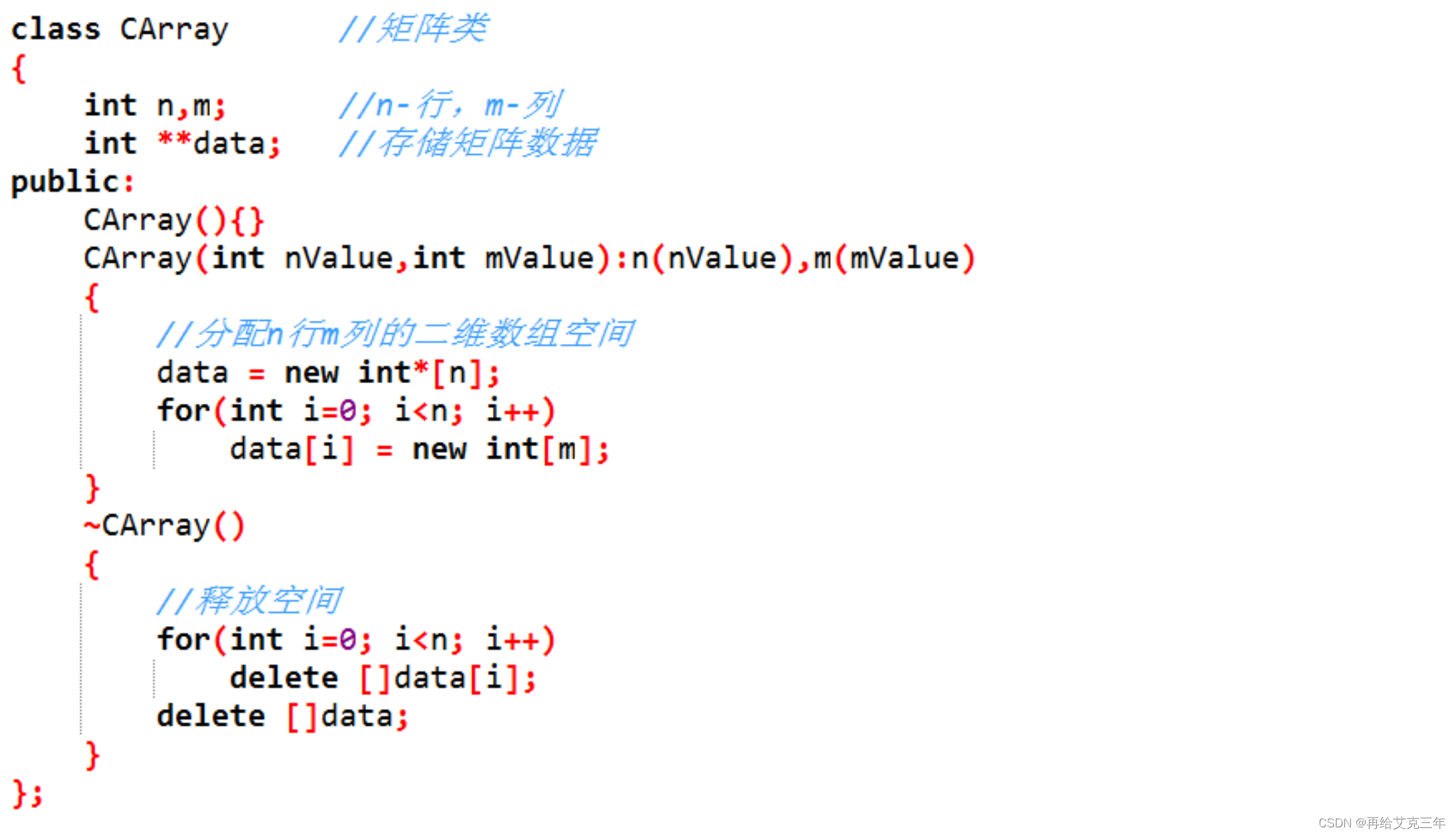
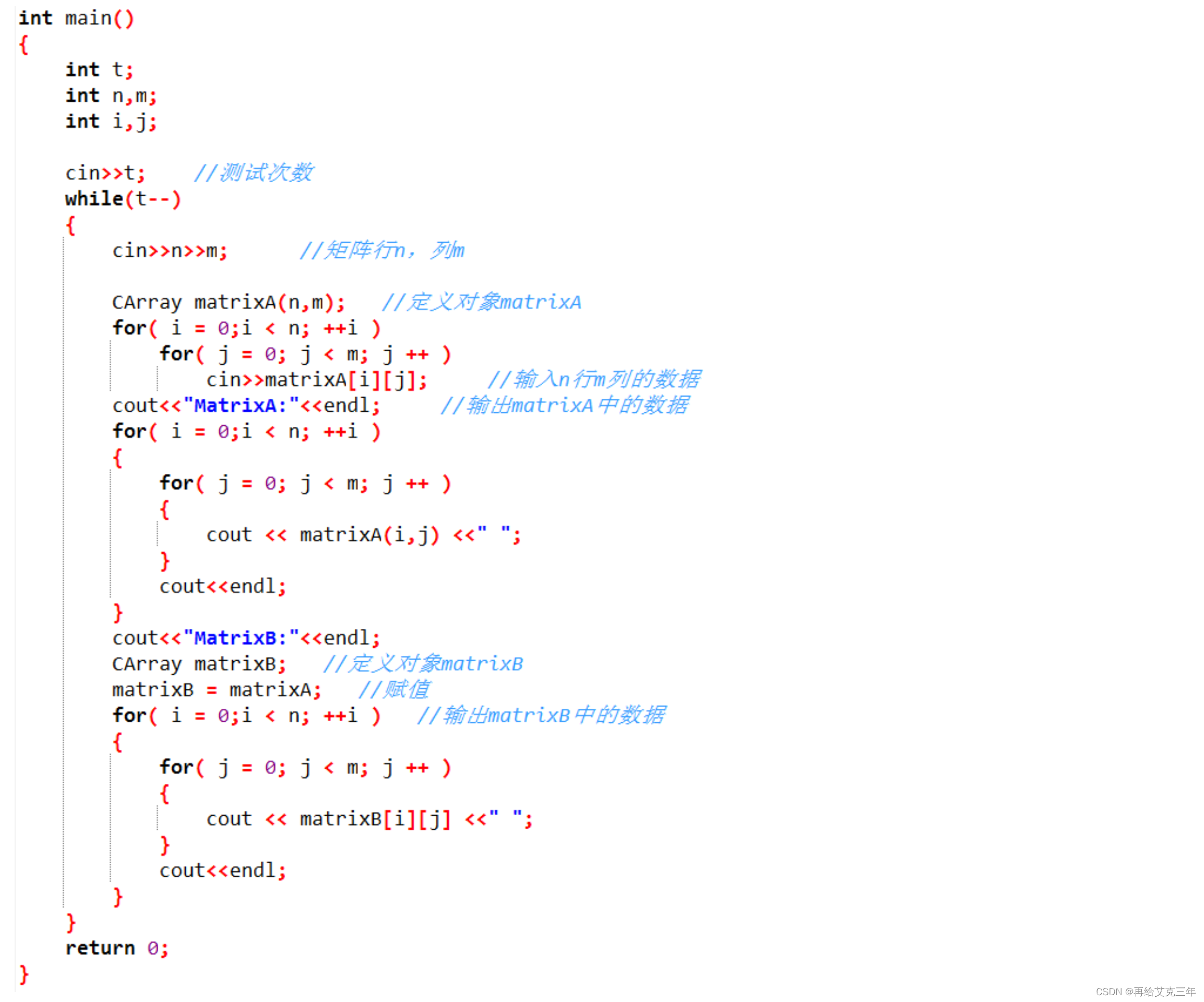
输入要求:
测试次数
每组测试数据格式如下:
正整数n、m,分表表示矩阵的行、列
n*m行整数数据
输出要求:
每组测试数据输出矩阵数据两次,具体输出格式见样例。
输入样例:
2
3 3
1 2 3
4 5 6
7 8 9
2 4
10 20 30 40
50 60 70 80
输出样例:
MatrixA:
1 2 3
4 5 6
7 8 9
MatrixB:
1 2 3
4 5 6
7 8 9
MatrixA:
10 20 30 40
50 60 70 80
MatrixB:
10 20 30 40
50 60 70 80 代码示例:
#include<iostream>
#include<iomanip>
#include<cstring>
#include<string>
#include<cmath>
#include<algorithm>
using namespace std;
class CArray
{
private:
int n, m;
int** data;
public:
CArray() {}
CArray(int nValue, int mValue) :n(nValue), m(mValue)
{
data = new int* [n];
for (int i = 0; i < n; i++)
data[i] = new int[m];
}
CArray(const CArray& a)
{
n = a.n;
m = a.m;
data = new int* [n];
for (int i = 0; i < n; i++)
data[i] = new int[m];
for (int i = 0; i < n; ++i)
for (int j = 0; j < m; j++)
data[i][j] = a.data[i][j];
}
~CArray()
{
for (int i = 0; i < n; i++)
delete[]data[i];
delete[]data;
}
CArray& operator = (const CArray& rhs)// = 运算符重载
{
n = rhs.n;
m = rhs.m;
data = new int* [n];
for (int i = 0; i < n; i++)
data[i] = new int[m];
for (int i = 0; i < n; ++i)
for (int j = 0; j < m; j++)
data[i][j] = rhs.data[i][j];
return *this;
}
int* operator [](const int x)//两个特殊的运算符重载
{
return data[x];
}
int operator () (int x, int y)
{
return data[x][y];
}
};
int main()
{
int t;
int n, m;
int i, j;
cin >> t;
while (t--)
{
cin >> n >> m;
CArray matrixA(n, m);
for (i = 0; i < n; ++i)
for (j = 0; j < m; j++)
cin >> matrixA[i][j];
cout << "MatrixA:" << endl;
for (i = 0; i < n; ++i)
{
for (j = 0; j < m; j++)
{
cout << matrixA(i, j) << " ";//重载()符号
}
cout << endl;
}
cout << "MatrixB:" << endl;
CArray matrixB;
matrixB = matrixA;
for (i = 0; i < n; i++)
{
for (j = 0; j < m; j++)
{
cout << matrixB[i][j] << " ";//重载[]符号,本质是返回了一个指针
}
cout << endl;
}
}
return 0;
}特殊的运算符重载
题目七:X的放大与缩小(运算符重载)
题目描述:
X字母可以放大和缩小,变为n行X(n=1,3,5,7,9,...,21)。例如,3行x图案如下:
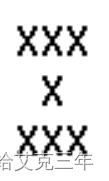
现假设一个n行(n>0,奇数)X图案,遥控器可以控制X图案的放大与缩小。遥控器有5个按键,1)show,显示当前X图案;2)show++, 显示当前X图案,再放大图案,n+2;3)++show,先放大图案,n+2,再显示图案;4)show--,显示当前X图案,再缩小图案,n-2;5)--show,先缩小图案,n-2,再显示图案。假设X图案的放大和缩小在1-21之间。n=1时,缩小不起作用,n=21时,放大不起作用。
用类CXGraph表示X图案及其放大、缩小、显示。主函数模拟遥控器,代码如下,不可修改。请补充CXGraph类的定义和实现。

输入要求:
第一行n,大于0的奇数,X图案的初始大小。
第二行,操作次数
每个操作一行,为show、show++、show--、--show、++show之一,具体操作含义见题目。
输出要求:
对每个操作,输出对应的X图案。
输入样例:
3
5
show
show++
show++
++show
--show
输出样例:
XXX
X
XXX
XXX
X
XXX
XXXXX
XXX
X
XXX
XXXXX
XXXXXXXXX
XXXXXXX
XXXXX
XXX
X
XXX
XXXXX
XXXXXXX
XXXXXXXXX
XXXXXXX
XXXXX
XXX
X
XXX
XXXXX
XXXXXXX代码示例:
#include<iostream>
#include<iomanip>
#include<cstring>
#include<string>
#include<cmath>
#include<algorithm>
using namespace std;
class XGraph
{
private:
int n;
public:
XGraph(int nn) :n(nn) {}
XGraph(XGraph& rhs)
{
n = rhs.n;
}
XGraph& operator++()//前置++,返回的是引用;前置用引用则是为了不产生临时变量,可以减少内存的消耗。
{
if (this->n <= 19)
{
this->n += 2;
}
return *this;
}
XGraph operator++(int)//后置++,返回的是临时对象,因为后置的时候原来的对象已经被++改变了。
{ //后置的函数的声明里面参数列表中比前置多了一个int,这里的int其实是作为区分前后置的标志,在函数体里面并没有直接地用到。
XGraph temp = *this;
if (this->n <= 19)
{
this->n += 2;
}
return temp;
}
XGraph& operator--()//原理与++或--相同
{
if (this->n >= 3)
{
this->n -= 2;
}
return *this;
}
XGraph operator--(int)
{
XGraph temp = *this;
if (this->n >= 3)
{
this->n -= 2;
}
return temp;
}
friend ostream& operator<<(ostream& out, const XGraph& rhs);//输出运算符重载,记住特定的格式
};
ostream& operator<<(ostream& out, const XGraph& rhs)
{
for (int i = 0; i < (rhs.n + 1) / 2; i++)
{
for (int j = 0; j < i; j++)
{
cout << " ";
}
for (int j = i; j < rhs.n - i; j++)
{
cout << "X";
}
cout << endl;
}
for (int i = (rhs.n + 1) / 2; i < rhs.n; i++)
{
for (int j = rhs.n - 1 - i; j > 0; j--)
{
cout << " ";
}
for (int j = rhs.n - 1 - i; j <= i; j++)
{
cout << "X";
}
cout << endl;
}
return out;
}
int main()
{
int t, n;
string command;
cin >> n;
XGraph xGraph(n);
cin >> t;
while (t--)
{
cin >> command;
if (command == "show++")
{
cout << xGraph++ << endl;
}
else if (command == "++show")
{
cout << ++xGraph << endl;
}
else if (command == "show--")
{
cout << xGraph-- << endl;
}
else if (command == "--show")
{
cout << --xGraph << endl;
}
else if (command == "show")
cout << xGraph << endl;
}
return 0;
}注意区分前++ / --和后++ / -- 的区别,前置返回引用,后置返回临时对象!
题目八:集合(运算符重载)
题目描述:
集合是由一个或多个确定的元素所构成的整体。集合的运算有并、交、相对补等。
集合A和集合B的交集:由属于A且属于B的相同元素组成的集合。
集合A和集合B的并集:由所有属于集合A或属于集合B的元素所组成的集合。
集合B关于集合A的相对补集,记做A-B:由属于A而不属于B的元素组成的集合。
假设集合A={10,20,30},集合B={1,10,50,8}。则A与B的并是{10,20,30,1,50,8},A与B的交是{10},B关于A的相对补集是{20,30}。
定义整数集合类CSet,属性包括:集合中的元素个数n,整型指针data存储集合中的元素。
方法有:重载输出,按样例格式输出集合中的元素。
重载+运算符,求集合A和集合B的并集,并返回结果集合。
重载-运算符,求集合B关于集合A的相对补集,并返回结果集合。
重载*运算符,求集合A和集合B的交集,并返回结果集合。
主函数输入集合A、B的数据,计算集合的并、交、相对补。
可根据题目,为CSet类添加需要的成员函数。
输入要求:
测试次数
每组测试数据两行,格式如下:
第一行:集合A的元素个数和元素
第二行:集合B的元素个数和元素
输出要求:
每组测试数据输出如下:
第一行:集合A
第二行:集合B
第三行:A和B的并
第四行:A和B的交
第五行:B关于A的相对补集 与 A关于B的相对补集的并,即(A-B)+(B-A)
每组测试数据间以空行分隔。
输入样例:
2
3 10 20 30
4 10 1 2 3
5 100 2 3 4 -10
6 -34 12 2 4 90 100
输出样例:
A:10 20 30
B:10 1 2 3
A+B:10 20 30 1 2 3
A*B:10
(A-B)+(B-A):20 30 1 2 3
A:100 2 3 4 -10
B:-34 12 2 4 90 100
A+B:100 2 3 4 -10 -34 12 90
A*B:100 2 4
(A-B)+(B-A):3 -10 -34 12 90代码示例:
#include<iostream>
#include<iomanip>
#include<cstring>
#include<string>
#include<cmath>
#include<algorithm>
using namespace std;
class Set
{
private:
int n;
int* data;
public:
Set(int nn, int* arr) :n(nn)
{
data = new int[n];
for (int i = 0; i < n; i++)
{
data[i] = arr[i];
}
}
Set(Set& rhs) :n(rhs.n)
{
for (int i = 0; i < n; i++)
{
data[i] = rhs.data[i];
}
}
~Set()
{
delete[]data;
}
Set operator + (const Set& rhs)
{
int count = 0;
int mark[100] = { 0 };
for (int i = 0; i < this->n; i++)
{
for (int j = 0; j < rhs.n; j++)
{
if (this->data[i] == rhs.data[j])
{
count++;
mark[j] = 1;
}
}
}
int c = this->n + rhs.n - count;
int* crr = new int[c];
for (int i = 0; i < this->n; i++)
{
crr[i] = this->data[i];
}
int cnt = 0;
for (int i = this->n; i < c; i++)
{
while (1)
{
if (mark[cnt] == 0)
{
crr[i] = rhs.data[cnt];
cnt++;
break;
}
else
{
cnt++;
}
}
}
Set C(c, crr);
return C;
}
Set operator - (const Set& rhs)
{
int count = 0;
int mark[100] = { 0 };
for (int i = 0; i < this->n; i++)
{
for (int j = 0; j < rhs.n; j++)
{
if (this->data[i] == rhs.data[j])
{
count++;
mark[i] = 1;
}
}
}
int c = this->n - count;
int* crr = new int[c];
int cnt = 0;
for (int i = 0; i < c; i++)
{
while (1)
{
if (mark[cnt] == 0)
{
crr[i] = this->data[cnt];
cnt++;
break;
}
else
{
cnt++;
}
}
}
Set C(c, crr);
return C;
}
Set operator * (const Set& rhs)
{
int count = 0;
int mark[100] = { 0 };
for (int i = 0; i < this->n; i++)
{
for (int j = 0; j < rhs.n; j++)
{
if (this->data[i] == rhs.data[j])
{
count++;
mark[i] = 1;
}
}
}
int c = count;
int* crr = new int[c];
int cnt = 0;
for (int i = 0; i < c; i++)
{
while (1)
{
if (mark[cnt] == 1)
{
crr[i] = this->data[cnt];
cnt++;
break;
}
else
{
cnt++;
}
}
}
Set C(c, crr);
return C;
}
friend ostream& operator<<(ostream& out, const Set& rhs);
};
ostream& operator<<(ostream& out, const Set& rhs)
{
for (int i = 0; i < rhs.n; i++)
{
cout << rhs.data[i];
if (i != rhs.n - 1)
{
cout << " ";
}
else
{
cout << endl;
}
}
return out;
}
int main()
{
int t;
cin >> t;
while (t--)
{
int a;
cin >> a;
int* arr = new int[a];
for (int i = 0; i < a; i++)
{
cin >> arr[i];
}
Set A(a, arr);
int b;
cin >> b;
int* brr = new int[b];
for (int i = 0; i < b; i++)
{
cin >> brr[i];
}
Set B(b, brr);
cout << "A:" << A;
cout << "B:" << B;
cout << "A+B:" << A + B;
cout << "A*B:" << A * B;
cout << "(A-B)+(B-A):" << (A - B) + (B - A);
cout << endl;
}
return 0;
}问题考察的运算符重载不难,但是算法较麻烦!
题目九:OOP CString字符串拼接(深拷贝与运算符重载)
题目描述:
定义一个CString类如下:
class CString {
char* s;
int n;
public:
CString(char* const _s=nullptr) : s(nullptr), n(0) {
if (!_s) return;
n = strlen(_s);
s = new char[n + 1]{};
strncpy(s, _s, n); // 记得 #include <cstring>
}
// 1. 要求重载 '+' 运算符, 实现两个CString对象相加的结果
// (不能改变原来的两个CString对象)
// ...可以补充其它任意函数...
// (注意:只能添加(成员)函数,不能添加成员变量,不能修改已有定义)
};
// 2. 要求重载 "<<" 运算符以输出CString
主函数如下:(不可修改)
int main() {
int n;
char input[64 + 1]{}; // ! strlen(s) + 1
cin >> n;
while (n--) {
cin >> input;
CString s1(input);
cin >> input;
CString s2(input);
CString sEmpty; // !
delete new CString(s1 = s1+s2); // !
cout << s1 + sEmpty << endl
<< sEmpty + s2 << endl
<< s1 + s2 << endl
<< endl;
}
return 0;
}
输出要求:
第1行: 1个数字n, 表示测试次数
以下n行: 每行两个字符串, 用空格分隔
输出要求:
参见主函数或样例输出
输入样例:
3
abcd efg
abc defgh
abcde fghi输出样例:
abcdefg
efg
abcdefgefg
abcdefgh
defgh
abcdefghdefgh
abcdefghi
fghi
abcdefghifghi代码示例:
#include<iostream>
#include<iomanip>
#include<cstring>
#include<string>
#include<cmath>
#include<algorithm>
using namespace std;
class String
{
char* s;
int n;
public:
String(char* const _s = nullptr) : s(nullptr), n(0)
{
if (!_s) return;
n = strlen(_s);
s = new char[n + 1] {};
strncpy(s, _s, n);
}
friend String operator + (const String& s1, const String& s2)//+运算符重载
{
char* c = new char[s1.n + s2.n + 1];
strncpy(c, s1.s, s1.n);//strncpy(arr1, arr2, n),将arr2长度为n复制到arr1中
strncpy(c + s1.n, s2.s, s2.n);
c[s1.n + s2.n] = '\0';
String temp(c);
return temp;
}
friend ostream& operator<<(ostream& out, const String& rhs);
};
ostream& operator <<(ostream& out, const String& rhs)
{
for (int i = 0; i < rhs.n; i++)
{
out << rhs.s[i];
}
return out;
}
int main()
{
int n;
char input[64 + 1]{};
cin >> n;
while (n--)
{
cin >> input;
String s1(input);
cin >> input;
String s2(input);
String sEmpty;
delete new String(s1 = s1 + s2);
cout << s1 + sEmpty << endl
<< sEmpty + s2 << endl
<< s1 + s2 << endl
<< endl;
}
return 0;
}记住strncpy的用法!























 662
662











 被折叠的 条评论
为什么被折叠?
被折叠的 条评论
为什么被折叠?










